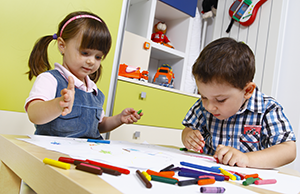Early Childhood Environments: Designing Effective Classrooms
Assessment
Take some time now to answer the following questions. Please note that the IRIS Center does not collect your Assessment responses. If this is a course assignment, you should turn them in to your professor using whatever method he or she requires. If you have trouble answering any of the questions, go back and review the Perspectives & Resources pages in this module.
 List five reasons why well-designed classrooms are important for young children.
List five reasons why well-designed classrooms are important for young children. - Identify and discuss at least three key aspects of each component of a well-designed early childhood environment: physical, social, and temporal.
- Describe three unique considerations for designing an environment for infants and young toddlers.
- Describe three strategies that teachers can use to make the physical environment more accessible to children with disabilities.
- Mr. Hilton is a new teacher in a classroom of infants, ages six months to 12 months. He is feeling a little overwhelmed with the “flow” of the day, especially when it comes to arrivals of infants and parents, feeding time, and floor time with the infants. Review the three problem areas in the Before column, then make two suggestions per item in the After column. Use the letters P, S, or T to identify the environmental change you recommend to the physical (P), social (S), or temporal (T) aspect of the environment.
| Mr. Hilton’s Classroom | |
| Before | After |
| Traffic jams occur at the doorway as Mr. Hilton stands waiting for parents and infants to arrive. Toys are on the bookshelf at the doorway and out of reach. |
1. 2. |
| All infants are seated in infant seats, lined up side-by-side against the wall, and fed around noon according to the schedule. Parents provide formula or meal. |
1. 2. |
| Few toys in the corner of the room during floor time. Mr. Hilton sits in a rocker nearby to supervise, communicating only when young children try to use the same toy. |
1. 2. |